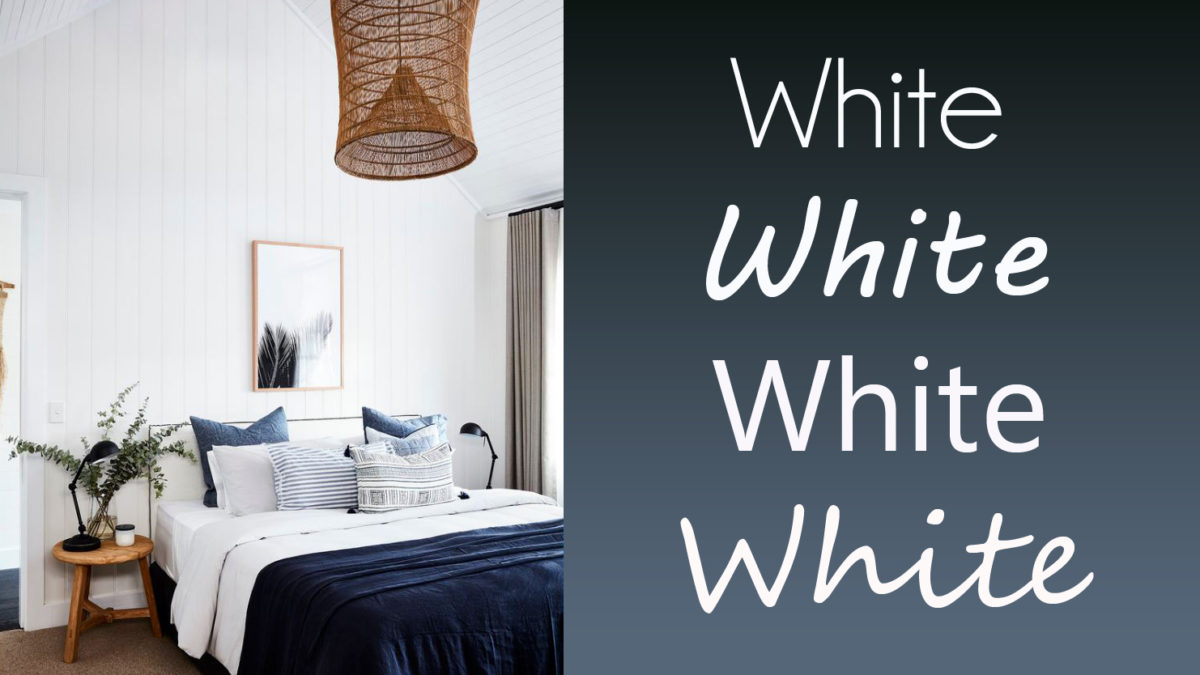FIFTY SHADES OF WHITE

There is no doubt that white paint is the most popular choice for walls in Australia. And it’s no wonder. White has the ability to make a space feel larger than it is, clean and calm. Just take a look at this beautiful room by Sydney Interior Designer Simone Matthews. Everything looks so calm and fresh. Studies have shown that people have physical reactions to colours so choosing the correct one for your home can have an actual affect on how you feel. But which white paint is that? I personally like to use Dulux “White on White” because it is a great modern backdrop to display my art….and it makes me think of marzipan and crisp white eggshells :). White paints are definitely not all made equally though. Cool whites could make a space feel crisp, clean and contemporary or they could make it feel cold and unwelcoming like ice. A warm white could make your room feel cosy and inviting, or then again it might make it feel dirty and old. So how do you choose I hear you say?
Warm whites have red, brown and yellow undertones. They often come across looking slightly cream. Think Dulux “Antique White USA”. They are used extensively in cooler climates due to the psychological perception of being warm. On the other hand, cool whites have blue, black and green undertones, for example Dulux “Lexicon”. We subconsciously relate them to ice, clouds, water and other cooling factors. To help you see the different whites place your paint swatches onto a piece of plain white copy paper.
Now that you can tell which white you’re looking at, lets figure out which one is going to be best for your home. Think about how you would like your home to feel. In Queensland we tend towards cooler and more neutral whites due to the heat. A room that is flooded with beautiful sunshine will benefit from a cool white as it creates the feeling of a cooler interior for your home and helps to balance the sunshine. Options might include Dulux “Vivid White” or “Lexicon Quarter”. However, if you have south facing rooms that do not receive as much light you may want to opt for a warmer white like Porters Paints “Irish Linen” or Dulux “White Dune Half”. If you have a home with greatly varying levels of light throughout consider Dulux “Natural white”. It is a slightly warm white that is a great go to as it suits traditional and modern homes. However every home will differ. I have seen the same white paint look blue in one persons home and a subtle grey in another. You must look at the paint swatches in your home.
Next, look at your homes architecture and other colours that come into play. Consider the style of your home. If you are aiming to create a period feel you may be better off selecting a biscuit colour such as Dulux “Humble Fawn” as your neutral. Although a stunning modern take on a period property could be achieved by painting your interiors with Porters Paints “Snow White”. For a beach property lean towards something like Dulux “White on White”. If you have low ceilings, paint your cornices and trims in the same white. It helps to extend the ceiling height and walls making the room feel larger. Just ensure you use an enamel for trims as it is more hard wearing.
Existing colours such as brick work seen through windows, painted walls and flooring colours will reflect colour and have an impact on your paint choice. White paint next to a red brick wall can result in pink tinged walls and brick that looks more pink than red. Opt for a white with a grey or green undertone instead like Dulux “Sky Painting”. Additionally, colours and textures you are painting over will have an affect on the final outcome. I always like to start with a good prep coat like Taubmans Easy Coat Prep.
Once you have selected a few paint colours you think may work, order A4 swatches from the supplier. Place these on your walls and view them at varying times of the day. Don’t forget to check them at night with your ceiling lights on. Move them around your house so that you can understand how the light play in your home will affect the colour. Once you think you’ve narrowed it down to two or three samples, pick up some sample pots and paint some large sections on your wall. Make sure you apply two coats and use a pencil to label the test patches. This will help you to make sure the original paint colour of your wall will not cause any problems and it will give you a larger section of colour to review.
Hopefully these tips will help you to select the right paint for your home. If you are still concerned ask an interior designer or get a recommendation for a great painter who can help you choose. Happy decorating :).
